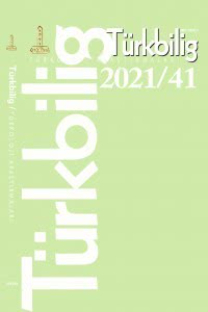KUTADGU BİLİG'DE KÖR- GÖRMEK : ÇOK ANLAMLILIK, METAFOR ve GRAMERLEŞME
Kör- To See in Kutadgu Bilig: Polysemy, Metaphor and Grammaticalization
___
- AIKHENVALD, A. Y. ve STORCH, A. (2013), Linguistic Expression of Perception and Cognition [Eds. Aikhenvald, A. Y. ve Storch, A.], Perception and Cognition in Language and Culture, Leiden: Brill Publication: 1-45.
- ALM-ARVIUS, C. (1993), The English Verb See: A Study in Multiple Meaning, Gothenburg: Acta Universitatis Gothoburgensis.
- ARAT, R., R. (1947), Kutadgu Bilig I: Metin, Ankara: TDK Yayınları.
- .........., (1985), Kutadgu Bilig II: Tercüme, Ankara: TDK Yayınları.
- ATA, A. (1993), Kutadgu Bilig Üzerinde Bir Düzenleme Denemesi: Kör mü? Kür mü?, Türkoloji Dergisi, XI: 301-308.
- BARCELONA, A. (2000), Metaphor and Metonymy at the Crossroads: A Cognitive Perspective, Berlin: Mouton de Gruyter.
- CULLEN, E., K. ve Van HORN, M., R (2011), Brainstem Pathways and Premotor Control, The Oxford Handbook of Eye Movements [Eds. Liversedge , S., P., Gilchrist, I., D. ve Everling, S.]: 151-172.
- DEREKO, A. (2007), Lockeda ve Lock-Öncesi Dil Felsefesinde Nesne-Ad İlişkisi, Sosyal Bilimler Araştırma Dergisi (SBARD), Sayı: 9: 97-120.
- EVANS, N., WILKINS, D. (2000), In the Minds Ear: The Semantic Extension of Perception Verbs in Australian Languages, Language, 76: 546-592.
- GISBORNE, N. (2010), The Event Structure of Perception Verbs, Oxford: Oxford University Press.
- GÖKÇE, F. (2014), Altay Dillerinde Ortak Bir Gramatikal Morfem {Zarf-Fiil Eki / Mastar Eki + GÖR-}Üzerine, Türkbilig: Türkoloji Araştırmaları, 2014/ 27: 1-12.
- .........., (2013), Gramerleşme Teorisi ve Türkçe Fiil Birleşmeleri, Ankara: Türk Kültürünü Araştırma Enstitüsü Yayınları.
- IBARRETXE-ANTUÑANO, I. (1999) Polysemy and Metaphor in Perception Verbs: A Cross-Linguistic Study, Phd Thesis, University of Edinburgh.
- .........., ve VALENZUELA-MANZANARES, J. (2010), Language as a Complex Dynamic System: A View from Cognitive Linguistics, Language as a Complex System [Eds. Bel-Enguix ve Jímenez-López], Cambridge Scholar Publishing: 3-39.
- JACKENDOFF, R., S. (1990), Semantic Structures, Cambridge: MIT Press.
- JOHNSON, C. (1999), Metaphor vs. Conflation in the Acquisition of Polysemy, [Eds. Hiraga, M. K., Sinha C., Wilcox, S.] Cultural, Psychological and Typological Issues in Cogntive Linguistics, Amsterdam/Philadelphia: John Benjamin Publishing Company: 155-169.
- KNOWLES, M. ve MOON, R. (2006), Introducing Metaphor, London and New York: Routledge.
- KURŁOWICZ, J. (1965), The Evolution of Grammatical Categories, Diogenes, 51: 55-71.
- LAKOFF, G. (1993), The Contemporary Theory of Metaphor, Metaphor and Thought Volume: 2: 202-251.
- ..........., ve JOHNSON, M. (1980), Metaphors We Live By, Chicago: University of Chicago Press.
- ..........., ve ........, (1999), Philosophy in the Flesh: The Embodied Mind and Its Challenge to Western Thought, New York: Published by Basic Books.
- MAIR, C. (2004), Corpus Linguistics and Grammaticalization Theory, [Eds. Lindquist, H., Mair, C.], Corpus Approaches to Grammaticalization in English, Amsterdam/Philadelphia: John Benjamins Publishing.
- MATISOFF, J. (1978), Variational Semantics in Tibeto-Burman: The Organic Approach to Lingustic Comparison, Philadelphia: Institute fort he Study of Human Issues.
- PEIRCE, C., S. (1998), Essential Peirce: Selected Philosophical Writings, Volume 2 (1893-1913), Peirce Edition Project, Bloomington: Indiana University Press.
- RADDEN, G. (2002), How Metonymic are Metaphors?, Metaphor and Metonymy in Comparision and Contrast, [Eds. Dirven, R. ve Pörings, R.], Berlin: Mouton de Gruyter: 407-434.
- REIMER, N. (2010), Introducing Semantics, Cambridge: Cambridge University Press.
- RUIZ, J., H. (2009), Understanding Tropes: At the Crossroads between Pragmatics and Cognition, Frankfurt: Peter Lang Publishing.
- STEEN, G., J. (2007), Finding Metaphor in Grammar and Usage, Amsterdam/Philadelphia: John Benjamins Publishing.
- SWEETSER, E., V. (1990), From Etymology to Pragmatics, Cambridge: Cambridge University Press.
- ŞÇERBAK, A. M. (1987), Oçerki Po Sravnitelnoy Morfologii Tyurkskih Yazıkov, Leningrad: Izdatelstvo Nauko.
- VANHOVE, M. (2008), Semantic Assocations Between Sensory Modalities, Prehension and Mental Perceptions, [Ed. Vanhove, M.] From Polysemy to Semantic Change, Amsterdam/Philadelphia: John Benjamins Publishing.
- VIBERG, A. (1983), The Verbs of Perception: A Typological Study, Linguistics, 21: 123-162.
- WHITT, R., J. (2010), Evidentiality and Perception Verbs in English and German, Oxford: Peter Lang Publications.
- ISSN: 1302-6011
- Yayın Aralığı: 2
- Başlangıç: 2000
- Yayıncı: Doç. Dr. Bülent Gül
XIX. YÜZYIL KIBRIS ŞER'İYE SİCİLLERİNDE LÂKAP VE UNVANLAR
KUTADGU BİLİG'DE KÖR- GÖRMEK : ÇOK ANLAMLILIK, METAFOR ve GRAMERLEŞME
ÇAĞDAŞ TÜRK TİYATROSUNDA SAMUEL BECKETT ETKİSİ: GÜLE GÜLE GODOT VE GODOT'YU BEKLEMEZKEN
TÜRK EDEBİYATINDA KADINLARIN ÖZYAŞAMÖYKÜLERİNE ZAMANDİZİNSEL VE BETİMSEL BİR BAKIŞ
B. Gulmira MADİYEVA, K. Manshuk MAMBETOVA, Eyüp BACANLI
KARAHANLI TÜRKÇESİNDE FARKLI BİR CÜMLE TÜRÜ: Kim(se)siz Ol'lu Cümleler
